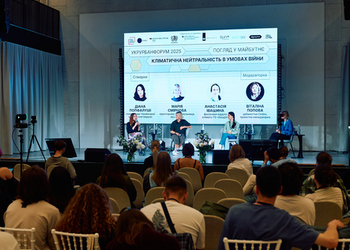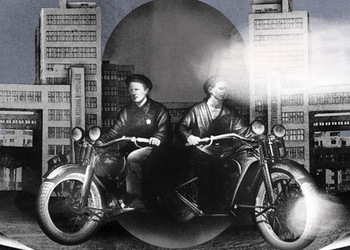«We ask people not to gather in crowds of more than three people on the terrace by the window.» No, it doesn’t concern you. You stay at home, please, if you could. However, for the delivery services workers, the question of whether to stay home or not is different.
As the reaction on the pandemic of the virus SARS-CoV-2 on the 12th of March 2020 Ukraine deploys national quarantine. Local authorities recommend people to stay at home. Schools and universities are closed, public events are canceled, Ukrainian national railway and private transportation companies suspended long-distance services. Since the 18th of March subway in Kyiv has stopped working and as of 23rd of March all the public transport in Kyiv only operates for the most critical city workers. Cafes and restaurants only perform home delivery services. And someone is needed to do these deliveries, to stay outside and risk their health. It is especially dangerous whereas no labor protection or extra payments are guaranteed for the majority of couriers during the quarantine. Social networks are full of pictures of deserted streets and city squares. Although couriers, who overnight became essential for the cities, remain there even in the time of the pandemic.
In November 2019, Internationaler Arbeitskreis e.V. in partnership with the Center for Society Research (CEDOS Think Tank) supported by the Ministry of Foreign Affairs of Germany organized educational exchanges for urban grassroots activists from Ukraine and Germany. The project was titled the Dialogue for Cohesive Cities. As the continuation of the project, Mistosite presents the series of media publications about the (un)fairness in the contemporary urban milieu.
In the following article, we explore how delivery services work in the cities, how protected and «romantic» is the labor of couriers.

Physical manifestations of digital economy
More and more often, these services are built on the sharing economy principles. These are business models that use technology to create conditions for exchanging goods or services. They sell access to something and function as peer-to-peer services. The most prominent examples are the international delivery services Lyft, Deliveroo, Foodora, Uber, Glovo. For almost two years, some of them have operated in Ukraine, too. The number of users is growing rapidly. In just over a year since Glovo entered the Ukrainian market, its client app has been installed by half a million Ukrainians, and the fraction of those who have placed two or more orders per month is one of the highest in Europe, reaching 40%.
Now couriers are everywhere. Within a few years, they have become an integral part of our everyday environment. People with colorful backpacks ride the subway, wait in cafes or just spontaneously gather in groups in various parts of the city trying to «catch» an order.
«For me, this is a 100% cyberpunk story. Especially in bad weather or at night on weekends, when the only people you can meet in the street are the disadvantaged or Glovo couriers,» writes Olha Shevchenko.
Jonas Ersland, a photographer and designer from Berlin, dedicated a special project to this, titled Public Waiters. He placed color-sensitive surveillance cameras in the center of Eindhoven, Netherlands, and created a series of online videos that record non-stop the movement trajectories and gatherings of couriers wearing the uniform of the relevant delivery services. This way, Ersland seeks to demonstrate how new forms of automatization in the food industry affect public spaces. How chaotic locations, where couriers gather, embody the digital economy, which supposedly exists beyond the physical realm.
In their ads for courier jobs, the services themselves often present deliveries as an opportunity to look at the city with new eyes while working. For instance, iPOST promises that its couriers can expect «not just delivering various things, but also an adventure in the city.» In its slogan, «Only you and the city,» UberEats romanticizes this work even more. Interestingly, the couriers themselves tend to agree that a peculiar urban romanticism plays a role in their everyday work and motivation.
«You would think, how can this work be attractive, it’s so thankless... But you get addicted. When you’ve worked as a courier for a few months, you won’t be able to work between four walls anymore,» shares Oleksiy (not his real name), 22, from Kyiv, a courier for one of the well-known delivery services. «Every day, you travel around the city, you are thrown from historic neighborhoods to new ones, you see the four different faces of the city: in the morning, during the day, in the evening, at night — essentially these are different cities. Different people in the streets, different traffic, different angles of sunlight, different rhythm of work at the restaurants themselves, different smells...»
«Couriers perceive the city as their own, it starts to feel much smaller than it actually is,» he adds.
More work, less life
But what lies behind this romantic facade?
According to the experts, these are hidden labor relations. Vitaliy Dudin, a lawyer at the Social Movement NGO, says that this is evidenced by the fact that companies like Glovo or Uber exercise control over the couriers, give them instructions and provide them with means of labor such as backpacks, while the mobile app is a commercial asset which allows the couriers to perform the relevant functions.
«The rules which Glovo couriers have to learn to regulate the process of labor itself, rather than define the requirements for the result of the finished work or the provided service, which is typical for civilian contracts,» says the lawyer. «And the relations between the courier and the company do not end after a certain result is achieved.»
See more about this in the material by Volodymyr Bohatyr, a lawyer and a Ph.D. in Law. Analyzing the way the development of digital platforms contradicts Ukraine’s legal field, the lawyer gives the example of a decision by the Supreme Court of Spain, which took a Glover’s side and recognized him as an employee dependent on the platform. «Without the platform, the person just wouldn’t be able to deliver food, so this app is de facto a means of production. And the other way around, without the couriers, the company just wouldn’t be able to carry out its activities, because they are in fact the company’s employees and perform the labor functions assigned to them,» writes Bohatyr.
Trade unions share a similar opinion. For instance, the Frankfurt Paper on Platform-Based Work, which has united trade unions in Europe and North America, focused a lot on the employment status of the people who work via the apps. The document’s conclusions warn about the risks of «digital feudalism.»
However, this employment through mobile apps is not registered in the form of labor contracts. Moreover, there is often no registration at all. Employment takes the form of so-called split labor relations or other kinds of atypical employment. We mean trilateral labor relations in which «the function of the employer is split between the de facto employer—that is, the end employer, and the de jure employer—that is, a kind of intermediary.» Digital platforms, such as Glovo or Uber, act as intermediaries who link the potential customer of a certain service to the person who carries it out. They call this activity «providing information services.»

Exhausting, long working hours
Delivery services emphasize that only the courier can decide how much he or she should work and when. But according to the couriers, in order to make 20,000 hryvnias a month, as Glovo promises, you will have to work up to 60-70 hours per week. A courier’s income is made up of a fixed payment for each order they carry out and bonuses for a certain number of delivered orders within a week. That is why the hours the courier will have to work to get a decent income depend on the bonus calculation system, which has changed throughout the service’s existence (the latest change even provoked several Glover protests in August 2019).
In order to receive the highest possible bonus, a Glover must fulfill 100 deliveries in a week. Given that the average delivery time is 35-45 minutes, this means over 75 working hours per week. It’s almost twice as much as allowed by the Labor Code, whose Article 50 provides that the normal length of working hours for employees cannot exceed 40 hours per week. However, digital service couriers are formally nobody’s employees. So they choose their working hours voluntarily. But how free is this choice?
According to Ukrainian State Statistics Service, employees of postal and courier companies have the lowest wages compared to representatives of all the other occupations. Since early 2020, the average Ukrainian wage in this sector is 6,306 hryvnias per month. Under these circumstances, an opportunity to make more, even though your working hours increase and you are less protected, can possibly become the only alternative.
The lives of the couriers who deliver your chicken wings or barbecue ribs are not defined by the labor law, but rather by the on-demand economy logic. It aims to «fulfill consumer demand via the immediate and flexible provisioning of goods and services» by independent individuals.
Dangerous speed
Working 70 hours a week and labor safety are things that can hardly go together. Moreover, under these conditions of excessive workload, the couriers act as traffic participants. Couriers for contemporary delivery services mostly use bicycles and mopeds.
«They break the rules because you need to go faster, faster, but bikes are not mopeds, they can’t go as fast, so you have to come up with new ways to make some money,» explains Oleksiy. «So people often cycle like crazy, they cross on red lights, ride against traffic, hit curbs, fall over and so on.»
According to the U.S. Bureau of Labor Statistics, transportation and delivery of goods using vehicles are among the 25 most dangerous jobs. The Bureau concludes that all jobs with the highest rates of fatal accidents share several labor conditions. One of them is driving for prolonged periods of time. In addition, motorbikes and mopeds are less impact-resistant than enclosed vehicles. They are not as noticeable for other drivers and pedestrians and less stable than cars. So motorbike riders are more vulnerable to bad weather. According to the U.S. National Highway Traffic Safety Administration, motorcycle riders’ chances of dying in a crash are 27 times higher per vehicle mile traveled than the chances of car drivers or passengers.
In Ukraine, the first fatal accident involving a Glovo courier happened in July 2019. The 20-year-old Mykhailo from Kharkiv died in a hospital after he was hit by a car while performing a delivery. In a while, the company introduced health and life insurance for the couriers who work via its platform, although there have been some complaints about it.
In some countries, these things were treated more seriously. For instance, in August last year in Buenos Aires, the capital of Argentina, the functioning of app-based food delivery services was temporarily suspended. The local court took this step after a 63-year-old courier for one of the services was hit by a car, but the company’s tech support was only interested in the state of the delivery. Despite the fact that the courier reported the trauma and inability to move. Since most city couriers rode bikes without protective helmets and had no insurance, the court concluded that the companies did not follow the country’s labor law and transportation rules.
Oleksiy has managed to work for almost all of the biggest food delivery companies through the apps that operate in Ukraine. According to him, when these services were just launching, they were much more strict about checking driving licenses for the mopeds. According to the Traffic Laws, a moped is a mechanical vehicle, and you need to have a license, registration, and insurance to drive it. «Now it has come to the situation when couriers do not just have no license to ride mopeds, many of them don’t even know that you need a license,» says Oleksiy. «These mopeds are mostly rented for good money from firms that profit off of this. And these people, many of them have never driven anything, they don’t know the rules, they don’t know the signs, they don’t know the markings.»
Oleh (not his real name) is a mechanic at a motorbike service which works with delivery couriers in one of Kyiv’s residential neighborhoods. He says that the rented mopeds are in bad condition (which the couriers are not always able to appreciate), so they break often. A faulty vehicle for a courier means not just additional repair expenses, but also losing a workday. This can be compensated only by more desperate work later.
The average price of renting a moped in Kyiv is about 300 hryvnias per day; that is, for 20 workdays, this will amount to 6,000. If you add the refueling costs—about 100 hryvnias per shift—the rented vehicle will cost the courier 8,000 hryvnias per month. Meanwhile, buying your own moped costs $300-600 for a used vehicle and from $700-800 for a new one. Service for a used moped will cost about 4,000-4,500 hryvnias per month, and for a new one, up to 3,000. The price of a new moped, according to the courier, can be covered in a month of non-stop working. Working for 70 hours a week, without unplanned sick days or days off. In addition, you have to store your vehicle somewhere for the night, which means additional costs which the courier has to cover on their own.
All of these factors can pose risks for the traffic situation. And not only on the roads: because traffic in Ukraine is not suitable for cyclists, couriers often choose sidewalks and pedestrian zones, creating another source of danger in the process. Bike couriers can hit pedestrians simply because of inattentiveness. Add the habit of drivers to park in pedestrian areas to this, and imagine the labyrinth that delivery service workers have to cross every day, living under constant deadline pressure.
Brings everything to you
The number of couriers on the roads and streets of our cities keeps growing, just like the revenue of the delivery platforms. What can we expect in the future, will deliveries fill not just our streets but our sky, too? Delivery drones are already being tested by giants such as Amazon and local food delivery apps such as the Irish service Flipdish.
Deliveries have not colonized the sky above our cities yet. However, small robot couriers are already driving on the sidewalks of some American cities. «Suddenly we’re introducing vehicles to places where cars currently aren’t,» says David King, assistant professor of urban planning at Arizona State University. «If you think communities complain bitterly about traffic now, wait until traffic is a bunch of small robots all over the place.»
«Automation is going to drive down the cost of these transactional deliveries tremendously, so we’re going to start delivering all kinds of things to our homes that typically we’re not,» comments King.
The whims and «needs» of us, big-city residents, who have been taught by the on-demand economy to momentarily get anything we want, will only grow. But how many vehicles and people are bringing everything to you already, right now?



